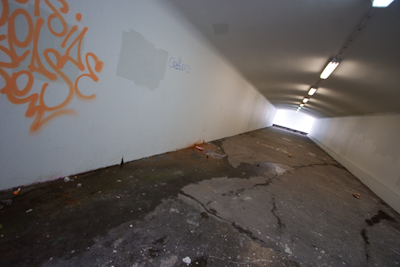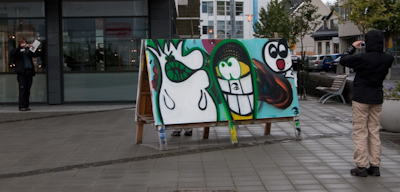The cultural Reykjavík
Now, a new blog entry about this tiny city at the northwest of Europe. It seems to me Reykjavík must be the Nordic countries capital of culture. This is of course not official and I guess quite a few people disagrees, but nevertheless my opinion. I find galleries, photographers, art schools concert halls, theatres and literature cafés  and you name it all over town. Not only are there far too many of them compared to the amount of people here (120 000 in Reykjavík and another 80 000 in the rest of “greater Reykjavík” including Kópavogur, Garðabær and Hafnarfjörður). I talked to some artists at Prikið and was told the government had “zero tolerance” for their art, graffiti. This first sounded similar to what is done in Oslo, where the city council found it a good idea after visiting their colleagues in Copenhagen. This zero tolerance for a line of art implies that if a piece or a tag is painted on a wall, the wall will be repainted shortly after. Interestingly, the zero tolerance only applies to graffiti, and not filth in general. The floor of this walking tunnel (photographed on my way into town from Perlan) shows what’s important. The floor of this tunnel was probably resurfaced around 1985 or so, and is rather filthy, so it’s obviously the act of removing graffiti is more for the dislike of the art/culture itself and not to make the city look better.
and you name it all over town. Not only are there far too many of them compared to the amount of people here (120 000 in Reykjavík and another 80 000 in the rest of “greater Reykjavík” including Kópavogur, Garðabær and Hafnarfjörður). I talked to some artists at Prikið and was told the government had “zero tolerance” for their art, graffiti. This first sounded similar to what is done in Oslo, where the city council found it a good idea after visiting their colleagues in Copenhagen. This zero tolerance for a line of art implies that if a piece or a tag is painted on a wall, the wall will be repainted shortly after. Interestingly, the zero tolerance only applies to graffiti, and not filth in general. The floor of this walking tunnel (photographed on my way into town from Perlan) shows what’s important. The floor of this tunnel was probably resurfaced around 1985 or so, and is rather filthy, so it’s obviously the act of removing graffiti is more for the dislike of the art/culture itself and not to make the city look better.
Now, there is a little difference between the Danish/Norwegian zero tolerance approach and the Icelandic one. A few years ago, the city council of Oslo refused to allow a Danish graffiti artist to have an outdoor exhibition in Studenterlunden in central  Oslo all because it was graffiti and because of this zero tolerance. In Oslo, there are a private few walls open for art and a few more private ones (notably those in Brennevinveien by Blå, one near Hausmania, some by Blitz and an old wall by Mir), but in the public zone, everything is banned. In Reykjavík and even Hafnarfjörður, the government seems to be allowing art on the street as long as it’s not painted on the actual walls. This approach seems healthy with me, but then, the Oslo city council now wants to ban even private walls with graffiti “to stop this contagious disease”. Who do they think they are fooling? When Pompeii was discovered and dug up around 1748, they found the well-preserved remains of a city that was destroyed in 79 AD. Amongst the findings in the newly discovered archaeologic gold mine of Pompeii, they found wall upon wall with ancient graffiti.
Oslo all because it was graffiti and because of this zero tolerance. In Oslo, there are a private few walls open for art and a few more private ones (notably those in Brennevinveien by Blå, one near Hausmania, some by Blitz and an old wall by Mir), but in the public zone, everything is banned. In Reykjavík and even Hafnarfjörður, the government seems to be allowing art on the street as long as it’s not painted on the actual walls. This approach seems healthy with me, but then, the Oslo city council now wants to ban even private walls with graffiti “to stop this contagious disease”. Who do they think they are fooling? When Pompeii was discovered and dug up around 1748, they found the well-preserved remains of a city that was destroyed in 79 AD. Amongst the findings in the newly discovered archaeologic gold mine of Pompeii, they found wall upon wall with ancient graffiti.
I’m not sure if this post says too much about what I feel about the culture here, but I’ll be posting it anyway. Cafés like Grái kötturinn or Babalú, (of which is the former still closed), those two bookshops down at Hvervisgötu, Kolaportið and the whole feeling of it all makes me want to name Reykjavík one of the most important cultural centres in the Nordic countries.
Just my two cents…
roy
Dette med Reykjavik som kulturby og islendingene som et av Europas store kulturfolk, stemmer faktisk bra med litt av min barnelærdom: En av lærerne mine mente bestemt det mens han med stor glød og entuisiasme fortalte oss om folket der ute på øya sin unike evne til å ta vare på språket sitt og ikke la det bli fosøpla av importerte låneord.
well, we do have quite a few graffiti walls, you must have noticed them! Here‘s one, f.ex.